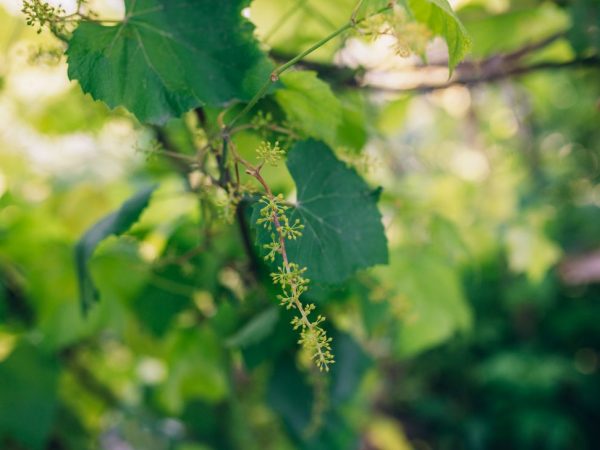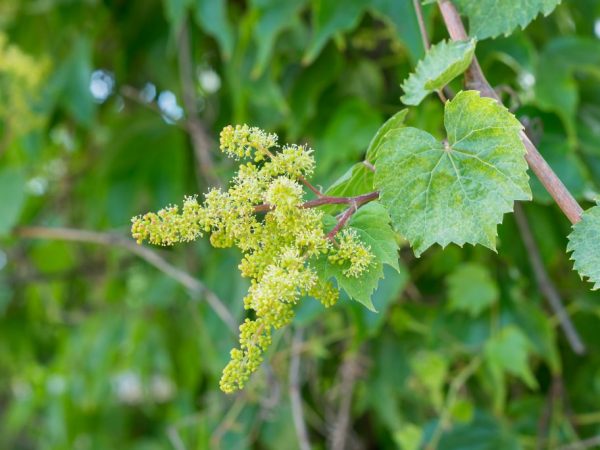Grape care during flowering
The flowering of grapes is a special period that determines the quantity and quality of the future harvest. How many ovaries the vine will give depends on how correct the care was at the stage of formation and opening of buds.

Grape care during flowering
Flowering duration
The calendar dates when the vineyard will bloom and the duration of the inflorescence opening period directly depend on the weather conditions. The beginning of the budding stage in the vine usually falls on the last days of May and the first days of June. Garden culture blooms for 8 to 14 days. At the same time, a temperature regime of 25-30 ° C increases the stage of budding, and a decrease in the degree to 15 ° C and below with simultaneous excessive moisture slows down the process of pollination and the formation of ovaries.
The flowering process is also affected by the lack of nutrition and moisture when the soil dries out and low fertility in a meter of the thickness of the upper layer.
The first to bloom are grapes of wine varietal varieties.
The process itself starts from the base of the grape flower, and after 2 days the inflorescence blooms completely. During this period, fallen caps are found in the garden under the grape bushes. The plant begins to shed them at a temperature of at least 10 ° C.
In most cases, grape inflorescences bloom at the same time, but some of the buds may be delayed in opening, which is quite acceptable.
Grape inflorescences open in the morning, from 6.00-11.00 hours. After opening, the susceptibility to pollination continues for 4-6 days, after which the ovary is formed.
Preparatory Measures
The vine is prepared for the period of bud formation and opening.
Bush formation
The excess green parts of the plant are cut off and young shoots are tied up, which are required to grow when creating frame support.
Watering
Regular watering helps to avoid cracking of the berries if the weather at the fruiting stage is rainy. The watering rate is 50 liters per 1 m of trellis, which is equivalent to 10 buckets for each grape bush. For greater efficiency, the vine is watered with mineral-organic complexes with boron. Watering is stopped 14 days before the calendar dates for the beginning of the budding stage.
Protection from pests and diseases
To protect the vine from pests, the plant is sprayed 3-5 days before the buds open. Against mildew, the vine is treated 7 days before the beginning of budding.
It is forbidden to spray grapes with chemicals against diseases and pests during flowering.
Fertilizers
At the stage of active swelling of the buds, mineral fertilizing complexes with potassium, nitrogen, phosphorus are introduced. Immediately before the budding stage, formulations rich in manganese, molybdenum and boron are used.
Flowering care

The plant needs to be well looked after
When grapes are in bloom, it is important for the plant to take proper care of it.
Pinching shoots
The budding stage of the vine coincides with the period of active growth of green shoots. If you find the caps discarded by the plant, the fruiting shoots must be pinched in one of the possible ways:
- By tight pinching. If the grape bushes have a large increase, the varietal variety is prone to shedding flowers and peas, or the plant has a female type of inflorescence, part of the shoot is removed, leaving no more than 5-8 large leaves above the inflorescence.
- By the method of soft pinching, when only the crown with 2 leaves is removed.
Pinching grape shoots at the stage of formation and opening of inflorescences inhibits the plant in growth for 2 weeks, which provides the culture with better nutrition and promotes the formation of more berries, increasing the total weight of the bunch by 20%.
Pollination
During budding of the vine, an optimum temperature of 17 ° C and moderate drought are required. Under such climatic conditions, pollination and ovary formation are successful. With insufficient moisture and drying out, as well as with rainy and cold weather, grapes bloom and pollinate less efficiently, often shedding inflorescences and ovaries, leading to peas.
Under unfavorable climatic conditions, additional artificial pollination is carried out:
- 2 blades are made of plywood, on which fur is glued, usually rabbit,
- by touching the fur on both sides, 10-20 flowers simultaneously collect pollen from the inflorescences of pollinating varieties and transfer them to fertilized flowers, periodically getting rid of sterile pollen, knocking the shoulder blades together.
Blooming grapes are pollinated on dry inflorescences after the morning dew has subsided in the time interval between 07.00 and 09.00, or after the raindrops have dried. Under unfavorable climatic conditions, the procedure is repeated at least 2-3 times. This increases the yield of berries by 15-30%.
Artificial pollination during flowering of grapes on bisexual varietal varieties under favorable climatic conditions can be carried out by simply shaking the frames (wire) on which the vine is held. The frequency of the procedure is 2-3 times during a short phase of opening the buds. Mechanical shaking of the pollen can be replaced by the action of a weak air flow directed from the pollinator at a distance of at least 0.5-0.8 m from the plant.
The quality of pollination is checked at the end of the flowering stage with a magnifying glass, revealing brown stigmas in the grape inflorescences.
Inflorescence formation
In varietal varieties bearing large bunches, excess bunches are manually removed, leaving only the most promising, which saves the plant from excessive stress.
Fertilizer
During the flowering period of grapes, the quality of the bunches is increased by introducing fertilizer complexes. This is done after 4-6 days after the appearance of the first blossoming inflorescences. Suitable fertilizers include formulations containing potassium, nitrogen and boron.
A number of budding-stimulating drugs increase bud opening. Spraying with stimulants is carried out in the phase of abundant disclosure of inflorescences. Dispersed sulfur is often used as stimulants. Inflorescences are pollinated with it in the morning hours at a distance of 1 m from the trellis.
Limitations
In the process of caring for a vine at the budding stage, a number of restrictions are adhered to:
- the plant is not watered, because excess moisture adversely affects the quality of pollination,
- the soil where the garden culture is planted is not dug up or weeded,
- do not use chemicals.
Conclusion
The flowering of grapes is an important stage in the development of horticultural culture, laying the quality and quantity of the future harvest. To ensure effective budding and further formation of berries, preparatory measures and proper care of the grapes during flowering allow.


